Sandkærgårds lade i Grønhøj fra 1791
Kartoffeltyskernes eneste bevarede verdslige bygning
DOI:
https://doi.org/10.7146/kuml.v71i71.142133Resumé
Sandkærgård’s barn at Grønhøj from 1791
The Potato Germans’ only surviving secular building
This article explores to what degree German immigrants imported, adopted or transformed building traditions during their ‘colonisation’ of the sparsely settled heathland of Alhede to the west of Viborg in the late 18th century. The last surviving secular building of the so-called Potato Germans, the barn at the farm of Sandkærgård, is presented as a case study. Between 1760 and 1763, King Frederik V of Denmark invited German immigrants from southern Hesse and Palatinate to settle in the heathlands to the west of Viborg. He aimed to intensify the agricultural use of this sandy, barren and sparsely populated land. About 300 families answered his call and began establishing new settlements in the Alhede area. They saw no future in their homeland, which had been devasted by wars, while the Prussian Seven Year’s War and the so-called French-Indian War prevented them from emigrating to America or Russia. But the new settlers quickly discovered that the heathland was not as fertile as advertised, and neither did the Danish government keep its promises of support. While most immigrants left Denmark again, about 60 families remained in the Alhede.
The barn at Sandkærgård is – apart from the parish church in Frederiks – the last preserved building from the immigration period. It has been dendrochronologically dated to 1791. Its half-timbered, single-storey construction without aisles matches fine contemporary Danish buildings. Its sparse use of braces, its single chain of rails on all sides and its roof construction all correspond to common developments in barns in the late 18th century, when the older reversed assembly roof went out of use. One feature, the elevated central part of the eave, has been perceived as a foreign trait rooted in the Hessian or Palatinate building tradition. But there are no evident parallels to this building in the immigrants’ homeland, while the elevated part is documented on the island of Als in northern Schleswig. Perhaps (German-speaking?) craftsmen from Als were engaged in building the new settlements. The barn at the farm of Sandkærgård therefore documents a process of integration and assimilation, where immigrants adopted the cultural traditions and workmanship of their new home.
Downloads
Publiceret
Versioner
- 2024-06-18 (2)
- 2023-12-04 (1)
Citation/Eksport
Nummer
Sektion
Licens
Fra og med årgang 2022 er artikler udgivet i Kuml med en licens fra Creative Commons (CC BY-NC-SA 4.0).
Alle tidligere årgange af tidsskriftet er ikke udgivet med en licens fra Creative Commons.


